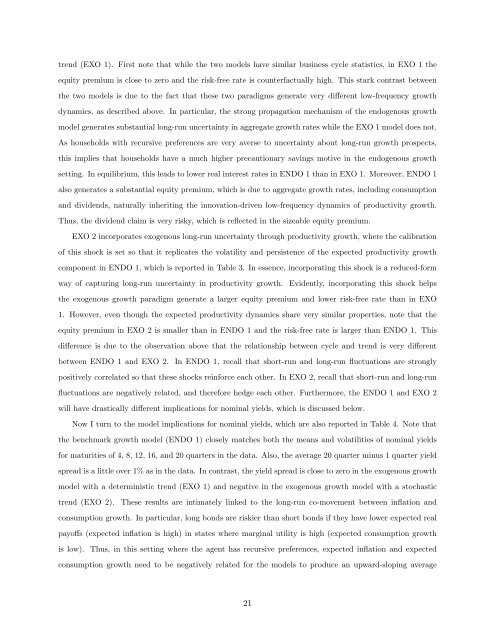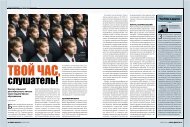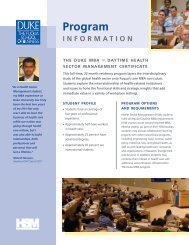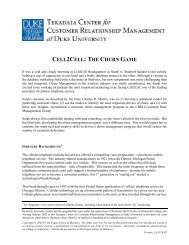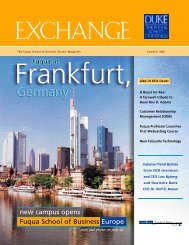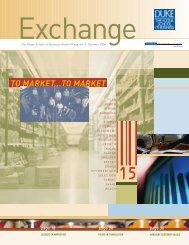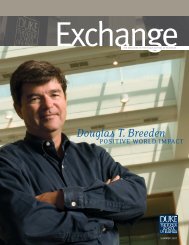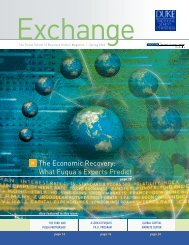Equilibrium Growth, Inflation, and Bond Yields - Duke University's ...
Equilibrium Growth, Inflation, and Bond Yields - Duke University's ...
Equilibrium Growth, Inflation, and Bond Yields - Duke University's ...
Create successful ePaper yourself
Turn your PDF publications into a flip-book with our unique Google optimized e-Paper software.
trend (EXO 1). First note that while the two models have similar business cycle statistics, in EXO 1 the<br />
equity premium is close to zero <strong>and</strong> the risk-free rate is counterfactually high. This stark contrast between<br />
the two models is due to the fact that these two paradigms generate very different low-frequency growth<br />
dynamics, as described above. In particular, the strong propagation mechanism of the endogenous growth<br />
model generates substantial long-run uncertainty in aggregate growth rates while the EXO 1 model does not.<br />
As households with recursive preferences are very averse to uncertainty about long-run growth prospects,<br />
this implies that households have a much higher precautionary savings motive in the endogenous growth<br />
setting. In equilibrium, this leads to lower real interest rates in ENDO 1 than in EXO 1. Moreover, ENDO 1<br />
also generates a substantial equity premium, which is due to aggregate growth rates, including consumption<br />
<strong>and</strong> dividends, naturally inheriting the innovation-driven low-frequency dynamics of productivity growth.<br />
Thus, the dividend claim is very risky, which is reflected in the sizeable equity premium.<br />
EXO 2 incorporates exogenous long-run uncertainty through productivity growth, where the calibration<br />
of this shock is set so that it replicates the volatility <strong>and</strong> persistence of the expected productivity growth<br />
component in ENDO 1, which is reported in Table 3. In essence, incorporating this shock is a reduced-form<br />
way of capturing long-run uncertainty in productivity growth. Evidently, incorporating this shock helps<br />
the exogenous growth paradigm generate a larger equity premium <strong>and</strong> lower risk-free rate than in EXO<br />
1. However, even though the expected productivity dynamics share very similar properties, note that the<br />
equity premium in EXO 2 is smaller than in ENDO 1 <strong>and</strong> the risk-free rate is larger than ENDO 1. This<br />
difference is due to the observation above that the relationship between cycle <strong>and</strong> trend is very different<br />
between ENDO 1 <strong>and</strong> EXO 2. In ENDO 1, recall that short-run <strong>and</strong> long-run fluctuations are strongly<br />
positively correlated so that these shocks reinforce each other. In EXO 2, recall that short-run <strong>and</strong> long-run<br />
fluctuations are negatively related, <strong>and</strong> therefore hedge each other. Furthermore, the ENDO 1 <strong>and</strong> EXO 2<br />
will have drastically different implications for nominal yields, which is discussed below.<br />
Now I turn to the model implications for nominal yields, which are also reported in Table 4. Note that<br />
the benchmark growth model (ENDO 1) closely matches both the means <strong>and</strong> volatilities of nominal yields<br />
for maturities of 4, 8, 12, 16, <strong>and</strong> 20 quarters in the data. Also, the average 20 quarter minus 1 quarter yield<br />
spread is a little over 1% as in the data. In contrast, the yield spread is close to zero in the exogenous growth<br />
model with a deterministic trend (EXO 1) <strong>and</strong> negative in the exogenous growth model with a stochastic<br />
trend (EXO 2). These results are intimately linked to the long-run co-movement between inflation <strong>and</strong><br />
consumption growth. In particular, long bonds are riskier than short bonds if they have lower expected real<br />
payoffs (expected inflation is high) in states where marginal utility is high (expected consumption growth<br />
is low). Thus, in this setting where the agent has recursive preferences, expected inflation <strong>and</strong> expected<br />
consumption growth need to be negatively related for the models to produce an upward-sloping average<br />
21


